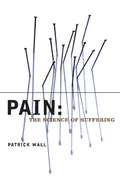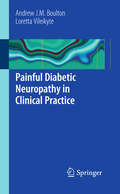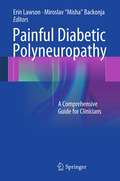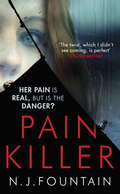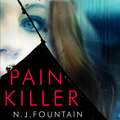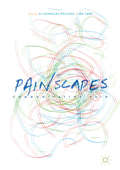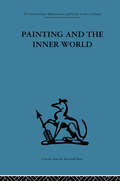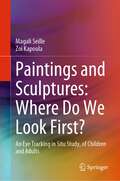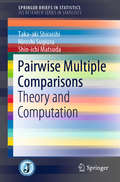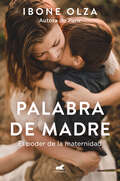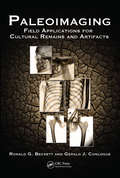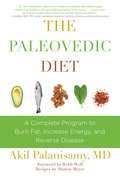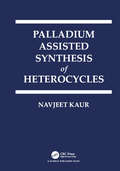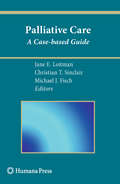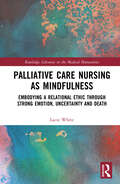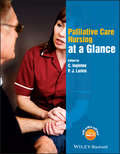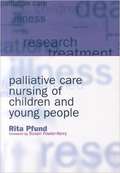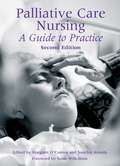- Table View
- List View
Pain: The Science of Suffering (Maps of the Mind)
by Patrick WallPain is one of medicine's greatest mysteries. When farmer John Mitson caught his hand in a baler, he cut off his trapped hand and carried it to a neighbor. "Sheer survival and logic" was how he described it. "And strangely, I didn't feel any pain." How can this be? We're taught that pain is a warning message to be heeded at all costs, yet it can switch off in the most agonizing circumstances or switch on for no apparent reason. Many scientists, philosophers, and laypeople imagine pain to operate like a rigid, simple signaling system, as if a particular injury generates a fixed amount of pain that simply gets transmitted to the brain; yet this mechanistic model is woefully lacking in the face of the surprising facts about what people and animals do and experience when their bodies are damaged. Patrick Wall looks at these questions and sets his scientific account in a broad context, interweaving it with a wealth of fascinating and sometimes disturbing historical detail, such as famous characters who derived pleasure from pain, the unexpected reactions of injured people, the role of endorphins, and the power of placebo. He covers cures of pain, ranging from drugs and surgery, through relaxation techniques and exercise, to acupuncture, electrical nerve stimulation, and herbalism. Pain involves our state of mind, our social mores and beliefs, and our personal experiences and expectations. Stepping beyond the famous neurologic gate-control theory for which he is known, Wall shows that pain is a matter of behavior and its manifestation differs among individuals, situations, and cultures. "The way we deal with pain is an expression of individuality."
Painful Bladder Syndrome: Controlling and Resolving Interstitial Cystitis through Natural Medicine
by Philip WeeksPainful bladder syndrome is a common and highly debilitating condition that Western medicine finds notoriously difficult to treat. Blending ancient and modern holistic medical traditions from both East and West, Philip Weeks guides the reader through the process of managing their symptoms effectively using a simple yet powerful combination of natural techniques, nutrition and herbal medicine. Applying his deep understanding of the principles of Ayurvedic and Chinese medicine, he provides holistic medical perspectives on the causes of PBS, as well as clear explanations of specific holistic methods and techniques for bringing symptoms under control, along with step-by-step instructions for introducing them to daily life. The book also looks in a holistic way at effective natural treatments for common co-existing conditions, including allergies, fibromyalgia, irritable bowel syndrome and chronic fatigue. The book ends with an easy-to-follow seven point protocol for recovery from PBS. This pragmatic and compassionate self-help guide will empower those with interstitial cystitis to gain control over their symptoms and achieve greater physical, emotional and spiritual wellbeing. It will also be of interest to complementary, alternative and mainstream health practitioners involved in treating or supporting those with the condition.
Painful Diabetic Neuropathy in Clinical Practice
by Loretta Vileikyte Andrew J.M. BoultonPainful Diabetic Neuropathy in Clinical Practice provides a concise, didactic and essential resource for clinicians in the management of neuropathic pain in diabetic patients. This volume opens with overviews of epidemiology, classification and clinical features, including a discussion of the negative effect of painful neuropathic symptoms on quality of life. These are followed by a chapter on diagnosis and staging, which includes approaches to history taking, clinical examination, pain assessment scales, testing and staging. The book concludes with a chapter on the various approaches in the management of neuropathic pain, including the most up-to-date guidelines on the pharmacological treatment of this condition. This concise handbook is an invaluable reference for primary care practitioners and diabetologists who wish to keep up to date with the diagnosis and management of neuropathic pain.
Painful Diabetic Polyneuropathy
by Miroslav Misha" Backonja Erin LawsonPainful diabetic polyneuropathy is the most common and disturbing of painful conditions experienced by people with diabetes. As the diabetes rate continues to grow, the number of people suffering from painful diabetic polyneuropathy will as well - increasing both patient suffering and demands on healthcare resources. Painful Diabetic Polyneuropathy covers all aspects of these painful disorders from pathophysiology and diagnosis, treatment and prevention, future approaches and the nursing perspective, to billing issues and the patient's experience. Written by experts in their fields, each chapter presents the full perspective of these painful disorders with an emphasis on evidence-based scientific information. Painful Diabetic Polyneuropathy is a comprehensive resource for general and family medicine practitioners, neurologists and pain medicine specialists. It will also serve as a resource for patients for education, support, and treatment sites.
Painkiller: Her pain is real ... but is the danger?
by N.J. FountainPainkiller is an edge-of-your-seat psychological thriller, perfect for fans of The Gift and Dear Amy.'If you've been left with a Girl on the Train-shaped shaped hole in your life, this book will undoubtedly fill it' Evening StandardMonica suffers from chronic neuropathic pain. Every second of her life is spent in agony, and she is coping with it the best she can. However, there are whole years of her life which are a blur to her.But when she finds a suicide note, written in her handwriting, she begins to question everything. She has no memory of writing it - so who did? And if someone tried to kill her once, what's to say they won't try again . . .
Painkiller: Her pain is real ... but is the danger?
by N.J. FountainI cannot go on like this. I feel such a burden to you. You are young and can start again. You deserve that chance. By the time you read this I will be dead. Do not grieve for me, for I am now without pain.Yours truly for ever,Monica Monica suffers from chronic neuropathic pain. Every second of her life is spent in agony, and she is coping with it the best she can. However, there are whole years of her life which are a blur to her. But when she finds what appears to be her own suicide note, Monica begins to question everything. She has no memory of writing it - so who did? And if someone tried to kill her once, what's to say they won't try again . . .A read-in-one-sitting edge-of-your-seat psychological thriller, perfect for fans of The Girl on the Train, I Let You Go and Before I Go To Sleep.
Painless Evidence-Based Medicine
by Maria Asuncion Silvestre Antonio L. Dans Leonila F. DansThis concise book presents evidence-based medicine to neophytes in simplified, friendly language. Basic concepts and application of research statistics are presented in simple sequences that are non-threatening even to the mathematically challenged. The authors emphasize two important aspects of appraisal: 1) how directly it provides an answer to the clinical problem at hand and 2) how well results can be generalized to various populations. Painless Evidence-Based Medicine: Offers a simplified approach to the complex or technical subject of evidence-based medicine, in terms of presentation as well as contentIs truly designed for the world market placeBreaks the subject into succinct chapters, each chapter being a self sufficient introduction to the topicIncludes pre-tested 'tackle boxes' throughout to help readers understand the issuesPainless Evidence-Based Medicine is an invaluable resource for medical students, clinicians, clinical epidemiology practitioners, and everyone involved in health care.
Painless Evidence-Based Medicine
by Antonio L. Dans Leonila F. Dans Maria Asuncion A. SilvestreThis concise book presents evidence-based medicine to neophytes in simplified, friendly language. Basic concepts and application of research statistics are presented in simple sequences that are non-threatening even to the mathematically challenged. The authors emphasize two important aspects of appraisal: 1) how directly it provides an answer to the clinical problem at hand and 2) how well results can be generalized to various populations. Painless Evidence-Based Medicine: Offers a simplified approach to the complex or technical subject of evidence-based medicine, in terms of presentation as well as content Is truly designed for the world market place Breaks the subject into succinct chapters, each chapter being a self sufficient introduction to the topic Includes pre-tested ‘tackle boxes’ throughout to help readers understand the issues Painless Evidence-Based Medicine is an invaluable resource for medical students, clinicians, clinical epidemiology practitioners, and everyone involved in health care.
Painscapes
by Ej Gonzalez-Polledo Jen TarrThis book brings into dialogue approaches from anthropology, sociology, visual art, theatre, and literature to question what kinds of relations, frames and politics constitute pain across disciplines and methodologies. Each chapter offers a unique window onto the notoriously difficult problem of how pain is defined and communicated. The contributors reimagine the value of images and photography, poetry, history, drama, stories and interviews, not as 'better' representations of the pain experience, but as devices to navigate the complexity of pain across different physical, social, and intersubjective domains. This innovative collection provides a new access point to the phenomenon of pain and the materialities, affects, structures and institutions that constitute it. This book will appeal to readers seeking to better understand pain's complexity and the social and affective ecologies through which pain is known, communicated and lived.
Painting and the Inner World (International Behavioural And Social Sciences Ser. #Vol. 99)
by Adrian StokesTavistock Press was established as a co-operative venture between the Tavistock Institute and Routledge & Kegan Paul (RKP) in the 1950s to produce a series of major contributions across the social sciences. This volume is part of a 2001 reissue of a selection of those important works which have since gone out of print, or are difficult to locate. Published by Routledge, 112 volumes in total are being brought together under the name The International Behavioural and Social Sciences Library: Classics from the Tavistock Press. Reproduced here in facsimile, this volume was originally published in 1963 and is available individually. The collection is also available in a number of themed mini-sets of between 5 and 13 volumes, or as a complete collection.
Paintings and Sculptures: An Eye Tracking in Situ Study, of Children and Adults
by Magali Seille Zoi KapoulaThe book presents three studies in which eye tracking data were collected at the Musée des Beaux-Arts in Rouen in June and July 2013. Overall, the results of those three studies highlight the knowledge gained from the analysis of the very first saccade in a museum context, when people look at paintings and statues. The first study analyzes how viewers orient their first saccade on paintings. This study shows that, in a museum, the first saccade is attracted toward the center of paintings. This attraction toward the paintings’ center is found in all the subjects’ groups that we have studied. Noteworthily, this effect is significantly less pronounced in individuals who never visit museums. It is among amateurs, who often visit museums, that the center attracts the most the first saccade. Among experts, painters or art history teachers, and to a lesser extent among amateurs, the pictorial composition largely determines the orientation of the first saccade. We indeed found that, as soon as the first saccade, experts orient their gaze toward the main subject. This phenomenon seems to be explained by the fact that experts immediately orient their gaze (here measured as the first saccade) toward the paintings’ location conveying the most meaning. It can either be the center, or a peripheral area, depending on whether the paintings’ most meaningful subject is located centrally or peripherally. The second study shows that the center does not attract the first saccade in 5-year-old children. This behavior appears later, in 8- to 10-year-old children. However, noticeably, the 8–10-year-old children orient significantly less frequently their first saccade toward the paintings’ center as adults do, and this is also true when one considers non-expert adult viewers. The results of the third study focus on statues and reveal a very different oculomotor behavior: Indeed, rather than looking at the center, statues’ viewers exhibit a clear tendency to saccade first at the statues’ contours. This stands in contrast with the behavior that we observe with paintings. Our study concludes that statues trigger a specific oculomotor behavior. The latter appears to be mostly driven by the physical presence that stone bodies incarnate. The movement and the climax of this movement, that sculptors manage to convey, thus turn out to attract the gaze in a unique fashion. The book concludes that the first saccade is a powerful indicator of the oculomotor behavior that greatly improves our comprehension of the unique relationship between a viewer and artworks.
Pairwise Multiple Comparisons: Theory and Computation (SpringerBriefs in Statistics)
by Hiroshi Sugiura Taka-aki Shiraishi Shin-ichi MatsudaThis book focuses on all-pairwise multiple comparisons of means in multi-sample models, introducing closed testing procedures based on maximum absolute values of some two-sample t-test statistics and on F-test statistics in homoscedastic multi-sample models. It shows that (1) the multi-step procedures are more powerful than single-step procedures and the Ryan/Einot–Gabriel/Welsh tests, and (2) the confidence regions induced by the multi-step procedures are equivalent to simultaneous confidence intervals. Next, it describes the multi-step test procedure in heteroscedastic multi-sample models, which is superior to the single-step Games–Howell procedure. In the context of simple ordered restrictions of means, the authors also discuss closed testing procedures based on maximum values of two-sample one-sided t-test statistics and based on Bartholomew's statistics. Furthermore, the book presents distribution-free procedures and describes simulation studies performed under the null hypothesis and some alternative hypotheses. Although single-step multiple comparison procedures are generally used, the closed testing procedures described are more powerful than the single-step procedures. In order to execute the multiple comparison procedures, the upper 100α percentiles of the complicated distributions are required. Classical integral formulas such as Simpson's rule and the Gaussian rule have been used for the calculation of the integral transform that appears in statistical calculations. However, these formulas are not effective for the complicated distribution. As such, the authors introduce the sinc method, which is optimal in terms of accuracy and computational cost.
Palabra de madre: El poder de la maternidad
by Ibone Olza¿Qué es ser madre? Palabra de madre parte de la historia personal de la autora, como madre y como profesional de la sanidad y activista, para plantear sus contradicciones e indecisiones en torno a la experiencia maternal, así como su desconcierto acerca de cómo los sistemas de salud de nuestra sociedad han ignorado y boicoteado la sabiduría reunida en relación con ella. «Me gustaría comprender qué clase de madre he sido. Captar, aunque sea de manera fugaz, el núcleo de mi experiencia maternal. Y así, de paso, comprender mejor la experiencia maternal en su sentido más amplio: la de todas las madres. Empecé a ser consciente de la profunda escisión, de cómo los sistemas de salud han ignorado a las madres y negado sus experiencias y conocimientos, y de cómo la ausencia de ese conocimiento maternal ha dado lugar a una ciencia sesgada y en muchos casos dañina. Todo ese conocimiento basado en la evidencia científica se estrella a diario contra la realidad de una sociedad heredera de décadas y siglos de desprecio hacia la maternidad.» Así, las circunstancias personales de cada madre, a menudo tortuosas y adversas, adquieren otro matiz cuando las analizamos desde lo histórico-social. «Mis circunstancias... Tendré que volver sobre ellas para lo que me propongo: comprender a la madre que fui y a la que ahora soy, con la esperanza de que tal vez sirva para entender y cuidar mejor al resto de las madres». Sobre Palabra de madre: «Todas las madres nos merecemos este libro. Porque todas sin excepción necesitamos estas palabras balsámicas para aplacar las soledades de la maternidad contemporánea. Ibone Olza nos regala un espejo de vivencias, luchas,intuiciones, dudas y cicatrices, que de tan propias se convierten en colectivas. Este libro viene a politizar la culpa endémica (y algunas otras heridas) que se nos inocula desde una sociedad profundamente maternofóbica. Y lo hace con toda la potencia de la ternura, la empatía radical y una catártica escritura».Silvia Nanclares, autora de Quién quiere ser madre «Palabra de madre es un libro honesto y emocionante, político y poético, capaz de acompañar a todas las madres que tienen todavía heridas abiertas en el cuerpo y en la memoria. Ibone Olza ha escrito este libro para todas nosotras. Y también para una sociedad que sigue dando la espalda a las madres».Carmen G. de la Cueva, autora de Mamá, quiero ser feminista
Pale Faces
by Charles L. BardesWho would have thought that something so commonplace as iron deficiency would lead to prehistoric ochre, Egyptian amulets, Renaissance alchemy, Victorian projections of maidenhood, and the astrophysical end of everything?Whether mild or deadly, anemia affects an essential body fluid: blood. In Pale Faces, Charles L. Bardes probes deeply into this illness as metaphor by exploring the impact of both science and culture on its treatment across the ages. His innovative "life" of this condition ranges widely through history, mythology, literature and clinical practice to examine how our notions of specific medical conditions are often deeply rooted in language, symbolism and culture.Delving into the annals of anemia and its treatment, he takes us on a fascinating journey back through the history of medicine-from the Greeks and ancient practices of bloodletting and magic up to the diagnostic rituals of a modern medical office. A scholar of the literary as well as the medical arts, Bardes gives us a beautifully written, free-ranging text, resonant with poetic associations yet anchored in concrete clinical experience.As a practicing physician, Bardes is also able to draw upon his direct experience with patients to demystify the doctor/patient relationship. Through detailed descriptions of the diagnostic processes involved in blood related conditions, as well as the particular understanding of the inner workings of the human body provided by modern medical science, we are treated to the complex ways in which doctors think.Charles L. Bardes, MD, is a practicing physician who teaches extensively at Weill Cornell Medical College, where he directs the Medicine Clerkship and serves as Associate Dean. He is the author of Essential Skills in Clinical Medicine, a guide for students and interns, and Pale Faces: The Masks of Anemia, the first book in the Bellevue Literary Press Pathographies series. He has been the Bernard DeVoto Fellow in Nonfiction at the Bread Loaf Writers' Conference and his essays have appeared in numerous journals, including Agni. He lives in New York.
Pale Rider: The Spanish Flu of 1918 and How It Changed the World
by Laura SpinneyIn 1918, the Italian-Americans of New York, the Yupik of Alaska and the Persians of Mashed had almost nothing in common except for a virus--one that triggered the worst pandemic of modern times and had a decisive effect on the history of the twentieth century. The flu pandemic of 1918-1920 was one of the greatest human disasters of all time. It infected a third of the people on Earth—from the poorest immigrants of New York City to the king of Spain, Franz Kafka, Mahatma Gandhi, and Woodrow Wilson. But despite a death toll of between 50 and 100 million people, it exists in our memory as an afterthought to World War I. In this gripping narrative history, Laura Spinney traces the overlooked pandemic to reveal how the virus traveled across the globe, exposing mankind&’s vulnerability and putting our ingenuity to the test. Drawing on the latest research in history, virology, epidemiology, psychology, and economics, Pale Rider masterfully recounts the little-known catastrophe that forever changed humanity.
Paleoimaging: Field Applications for Cultural Remains and Artifacts
by Ronald G. Beckett Gerald J. ConlogueMedical and industrial imaging methods have come to be recognized as powerful tools for documentation and data collection in many nontraditional settings. In Paleoimaging: Field Applications for Cultural Remains and Artifacts, two of the most preeminent experts in the field provide an in-depth examination of a range of imaging techniques and explain how these techniques can be applied to all aspects of forensic and archaeological analysis.The first part of the book examines paleoimaging multimodalities, highlighting the advantages and disadvantages of each imaging technique in different scenarios. The authors explore photography, conventional radiography, endoscopy, and various forms of computer-based imaging. Next, they present methodological and procedural standards for the various imaging techniques. They also demonstrate how multimodal imaging can assist nondestructive data collection of non-biological cultural artefacts. A final section addresses radiation safety and field safety concerns. Case studies, tables, and templates of forms for documentation of findings enhance the text with practical information.Filled with over 380 images, this book is supplemented with an accompanying downloadable resource in which the authors draw from their global experience in the paleoimaging of cultural remains and artefacts, offering a view of the diverse environments in which field paleoimaging is conducted. The breadth of the authors’ expertise and the rich images contained in the book and downloadable resources make this resource an essential reference for those who seek to explore the mysteries of the past.
Paleovedic Diet: A Complete Program to Burn Fat, Increase Energy, and Reverse Disease
by Akil PalanisamyA groundbreaking total-body program that incorporates principles of Paleo nutrition, Ayurvedic medicine, and cutting-edge research. In The Paleovedic Diet, Dr. Akil Palanisamy, MD, offers a comprehensive roadmap to optimal health combining the most effective aspects of the Paleo diet with Ayurveda, the time-tested traditional medical system of India, and the latest scientific research. Making complex ideas understandable and accessible, Dr. Akil delivers a simple, customized diet and lifestyle program to fit your unique body type. Drawing upon on his extensive training and clinical experience, Dr. Akil skillfully separates fact from fiction, providing clarity on issues such as gluten sensitivity, misconceptions about carbs, meat-eating versus vegetarianism, good and bad fats, unknown superfoods (you’ll be surprised to see what’s included), nutritional supplements, and the critically important gut bacteria comprising your microbiome. The Paleovedic Diet provides definitive, practical guidance on what to eat, how to move, how to sleep, how to manage stress, and even how to breathe. Dr. Akil's revolutionary three-week program (with meal plan and recipes) utilizes delicious nourishing foods, powerful healing spices, and intensive detoxification techniques to help you transform your body and mind.
Palin Parent-Child Interaction Therapy for Early Childhood Stammering
by Elaine Kelman Alison NicholasNow available in a fully revised and updated second edition, this practical manual is a detailed guide to the Palin Parent–Child Interaction Therapy programme (Palin PCI) developed at the Michael Palin Centre for Stammering (MPC). Palin PCI builds on the principle that parents play a critical role in effective therapy and that understanding and managing stammering is a collaborative journey between the child, parent and therapist. This book emphasises a need for open communication about stammering, offering a combination of indirect techniques such as video feedback, interaction strategies and confidence building, along with direct techniques to teach a child what they can do to help themselves. This second edition: Reflects the most up-to-date research in areas such as neurology, genetics, temperament and the impact of stammering on children and their families Offers photocopiable resources, such as assessment tools, information sheets and therapy handouts, to support the implementation of Palin PCI Focuses on empowerment through building communication confidence in children who stammer and developing knowledge and confidence in their parents Based on a strong theoretical framework, this book offers a comprehensive understanding of the Palin PCI approach in order to support generalist and specialist speech and language therapists as they develop their knowledge, skills and confidence in working with young children who stammer and their families.
Palladium Assisted Synthesis of Heterocycles
by Navjeet KaurThis book is a compilation of the recent applications of palladium catalysts in organic synthesis. The book demonstrates that it is a highly dynamic research field. This methodology has emerged as a powerful tool for the efficient and chemoselective synthesis of heterocyclic molecules. In the past few years, several strategies have been pointed out to pursue more efficient, sustainable, and environment friendly chemical processes. Among those strategies, catalysis and the design of new processes that avoid the use of toxic reagents have been the focus of intense research.
Palliative Atemtherapie: Die Bedeutung des Atems in der Palliative Care (essentials)
by Sabine HoherzIn diesem essential erfahren Sie, welche Bedeutung der Atem für den Menschen und insbesondere für Schwerstkranke und Sterbende hat. Der Band beschreibt die Grundlagen und Wurzeln der Palliativen Atemtherapie, ihre Wirkfelder und die Möglichkeiten ihrer Anwendung und vermittelt, was die Therapieform für Schwerstkranke und ihre Angehörigen zu leisten vermag. Auch die tiefgreifende spirituelle Dimension wird beschrieben, in der die Palliative Atemtherapie ihre Wirkung entfalten und den sterbenden Menschen auf heilsame Weise berühren kann.
Palliative Care
by Michael J. Fisch Jane E. Loitman Christian T. SinclairThis concise book offers an engaging case-based approach to palliative care. Experts in the field provide the essential aspects of daily practice with real cases presented as forums for the discussion of the complexities and practicalities of palliative treatment. Clearly structured, each chapter opens with bullet points highlighting the most relevant aspects of the case and points for discussion. Covering the full range of symptoms from cardiac care to pain management to wound healing, the vital elements of management are put into context through insightful dissections of history, examination, and goals of care. Each chapter concludes with a section on further reading. Palliative Care: a Case-based Guide provides the clinician with a crucial set of skills to address the challenging issues related to communication and symptom management. Care-oriented and practical, this book is ideal for all health care professionals committed to providing quality, compassionate care to end-of-life patients.
Palliative Care Nursing as Mindfulness: Embodying a Relational Ethic through Strong Emotion, Uncertainty and Death (Routledge Advances in the Medical Humanities)
by Lacie WhiteAs nurses, we hear about mindfulness all the time, but what does that actually mean in practice? In this book readers are invited into conversation to explore how mindfulness influences palliative care nurses’ approaches to caring for themselves and others through experiences of living-dying. Under the guise of stress reduction and self-care, the assumption often made is that mindfulness can smooth out difficult experiences. Instead, the objective of this inquiry is not to bypass the practice of caring in those spaces that are really hard, but to understand how nurses are working directly within them. Calling out from the shadows—and our bodies—the intensity of palliative care nursing practice arises. In this text, a dialogue unfolds of nurses caring in deeply meaningful practice environments while searching for ground that is perpetually shifting, uncertain, and fraught with suffering and strong emotion. Integrating literature across nursing, sociology, and contemplative scholarship, evocative stories from palliative care nurses lead in this conversation—their words in italics—showing how they are guided into action through connection with-in their bodies. At other times, stories show how nurses are taking pause and drawing on various somatic practices to unravel entanglements that touch on their own humanity. These stories also offer insight into how systemic forces, across educational and organizational institutions, are either enhancing or constraining the way nurses engage mindfulness as a relationally embodied ethic of care. This insightful volume is not a how-to guide, rather it is a timely resource exploring approaches for palliative care nurses to care for themselves and others with mindfulness and compassion. Those seeking nuanced perspectives, particularly in relation to embodying mindfulness through suffering and strong emotion, will be drawn to this text. Qualitative researchers studying emotionally sensitive topics may also find inspiration in the narrative, arts-based, and embodied methods that shape this inquiry.
Palliative Care Nursing at a Glance
by P. J. Larkin C. IngletonPalliative Care Nursing at a Glance is the perfect companion for nursing students, health and social care practitioners, and all those involved in palliative care delivery, both in the clinical and home setting. Written by an expert team of academics, nurses, educators and researchers it provides a concise and easy-to-read overview of all the concepts and clinical decision-making skills necessary for the provision of good-quality palliative and end-of-life care. Divided into six sections, the book includes coverage of all key clinical applications, principles of symptom management, palliative care approaches for a range of conditions and patient groups, exploration of the roles of the multi-professional team, as well as ethical challenges. Superbly illustrated, with full colour illustrations throughout Provides information on delivery of care in a range of settings Broad coverage makes it ideal reading for anyone involved in palliative care delivery User-friendly and accessible resource for those working in both specialist and non-specialist adult settings
Palliative Care Nursing of Children and Young People
by Rita Pfund"Children's palliative care is an evolving specialty and as such our knowledge base cannot remain static. This book constantly challenges the reader to critically analyze their own practices and beliefs within an evidence-based framework and as such makes a valuable contribution to the growing body of knowledge on this important subject." - Susan Fowler-Kerry, in the Foreword. This book caters for readers from different working environments and levels of experience. It is ideal for paediatric nurses with no specialist palliative care knowledge, and also for palliative care nurses with no specialist paediatric experience. Other healthcare professionals and therapists working with children, young people and their families will also find this book invaluable. It will also be ideal for undergraduate and postgraduate health and social care students, and professionals involved in children's hospices, community services and charity groups. "This book captures not just the rapidly evolving evidence base, but also as many current developments as possible and applies them in a meaningful way to the care of infants, children, and young people living with life-limiting illness, and their families. It offers an overview of contemporary issues and helps to stimulate the type of dialogue that can bring about the actions that will make a real difference for the children, young people and families in our care." - Rita Pfund, in the Preface.
Palliative Care Nursing: A Guide to Practice
by O’Connor Margaret Aranda SanchiaWritten by experienced authorities from around the world giving a wider international perspective on palliative nursing, this substantially expanded new edition has been specifically adapted to reflect working practices within the NHS. All nurses especially those that are new to palliative care, and those working in other areas of health where palliative skills are required, will find this essential reading.
